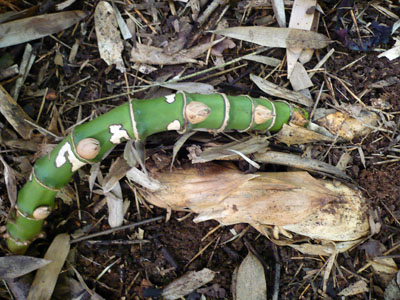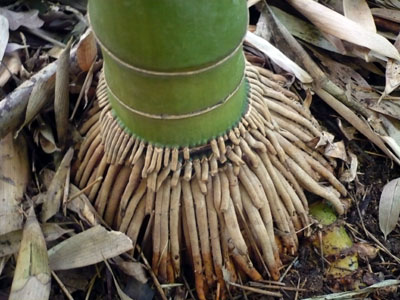Bamboo Biology - Morphology, Structure, and Anatomy
Bamboo Biology - Article Contents
- Taxonomy and Classification
- Morphology, Structure, and Anatomy
- Bamboo Behaviors
- Runners vs. Clumpers
- Identification
- The Bamboo Flower
The Anatomy of a Bamboo Plant
This section deals with the morphology and physiology of the bamboo plant. Morphology refers to the outward appearance of the plant’s components, while physiology refers to their biological function. We’ve done our best to merge these two distinctions to give you the overall idea of how bamboo works. Bamboo is structured beautifully and is unique from other plants and trees that share similar characteristics and features. The main components of a bamboo plant include rhizomes, roots, culms, branches, leaves, and flowers.
Rhizomes – Rhizomes are horizontal stems extending from the domain plant that travel underground with the objective of colonizing new territory. As rhizomes spread through the soil they collect and store the primary nutrients for growth. The storage of energy is the primary reason we see bamboo exhibit rapid and massive growth. This also gives bamboo plants the ability to utilize energy created from both photosynthesis and that which is stored in the rhizomes. Over time, the rhizomes will create an interconnected system of plants, all of which draw on the rhizomes for nutrients. For example, when a single bamboo plant has been introduced into an area, all other bamboo plants that emerge will belong to the same organism. In appearance, rhizomes are segmented and covered by a protective sheath. The leaves are reduced along the sheath, as they provide no photosynthetic benefit underground. The sheath provides the plant with the protection needed to breach the surface to form a culm. A healthy rhizome is usually slightly yellow or ivory in color, although possible colors may include red, brown, green, and purple. The appearance and behavior of rhizomes differs among species, and is divided into two main categories which include the pachymorph system and the leptomorph system.

Leptomorph bamboo rhizome protruding from the soil.
The pachymorph rhizome system, which is found in clumping bamboos, expands horizontally only by short distances each year. The rhizomes are generally short and thick in appearance. They curve upwards in close proximity to the domain plant. At the nodes, new rhizomes or roots can be produced. New culms can only form at the very tip of the rhizome. It is this feature that causes them to curve upwards and exhibit the clumping behavior. An advanced pachymorph system is very compact near the base of the plant, making removal or transplant of the bamboo exceptionally difficult.
The leptomorph rhizome system is found in running bamboos. In contrast to the pachymorph system, the rhizomes have a tendency to branch away from the domain plant. The rhizomes are generally long and thin in appearance and some species can send the rhizomes up to 20 feet away in a single growing season. At the nodes, they have the ability to produce buds that will form either new culms or rhizomes. Bamboos with a pachymorph rhizome system will be spaced over a wide area. They are invasive by design and it can be extremely difficult to remove a well established plant.
Roots – The primary function of roots in bamboo is to anchor the culm to the ground. Without a root system, the culm would be at vulnerable to damage from severe weather. This also allows the culm to hold more weight, giving it the ability to grow more leaves over wider distances. The roots do store nutrients, however this is not their primary function. In appearance, the roots are typically symmetrical in size and shape. They form at the base of the culm from the rhizome nodes, and generally go no deeper than one foot below the surface.

Typical Bamboo Root System Seen in the Phyllostachys Genus.
Culms – Culms are the most visibly distinguishable feature of a bamboo plant. Culms can vary in size, shape, color, and even smell. The appearance can range from thick or thin, tall or short, erect or bent, and can exhibit irregular patterns such as those found in Tortoise Shell Bamboo (P. heterocycla f . heterocycla ‘Kiko’). Most culms are round in shape, but some species can take on a square like appearance. The color of the culms also has a wide range of characteristics. Although the majority of bamboos are green, they can also be brown, black, yellow, or striped. One of the most popular garden bamboos, Black Bamboo (Phyllostachys nigra), is unique in the fact that the culms exhibit a nearly jet black color. The culms can also very in smell. One of the most interesting examples is Incense Bamboo (Phyllostachys atrovaginata), which has a waxy coat on the culms that emits a pleasant fragrance similar to incense.
New culms will generally emerge in the springtime, however timing will vary among species. As the culm shoots from the soil it will have already reached its maximum diameter, or girth. The newly emerging culm will grow rapidly and reach its final height by the end of the first growing season. The final size is determined by the local growing conditions, as well as the age and size of the bamboo grove.
Bamboo Culms with Significant Color Variation.
Branches - The majority of bamboo species will grow multiple branches from a single bud, located at the node. Some genera, such as Chusquea, have the ability to grow multiple buds at from each node.
Leaves – Leaves are present at every main portion of the bamboo plant, which includes the rhizomes, culm, and branches. The anatomy of the leaf itself includes a blade, sheath, and ligule. Leaves are first present in the rhizome where they are almost completely comprised of the sheath. At this stage, leaves serve as a protective cover to encase the rhizome as it travels underground. After the rhizome shoots through the soil and becomes a culm, the blade will become the predominant feature. The blade provides the photosynthetic function of the plant by converting sunlight into energy. The appearance of the blade varies among species. In some species the leaves are very large and less numerous, while other species have a large amount of very small leaves. The appearance of leaves plays a large role in the identification of bamboo.
Flowers – See the bamboo flower section.
